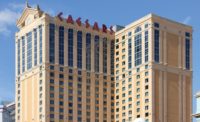Lightweight Prefabricated Insulation Panels
A Holistic View of Sustainability, Resiliency and Recyclability of CFS Makes the Case for Building Greener and Long-Term Impacts of the World’s Most Recycled Building Material.








While energy efficiency and sustainability in building design has been a major focus in recent years for architects and owners, the manufacturing of construction materials is often overlooked. Organizations such as the International WELL Building Institute, United States Green Building Council, and Leadership in Energy and Environmental Design all play significant roles in the designation of sustainable building materials and finishes, yet quantifying what goes into the resources it takes to produce these materials is namely analyzed through embodied energy studies alone, which shed light on only half of the sustainability story and benefits. Life-cycle analysis, recyclability, resiliency and embodied energy, together, paint a fuller picture of well-defined benefits.
What is often overlooked early in the preplanning and conceptual phases of a project are the long-term impacts that materials have on a project’s sustainability, and carbon footprint. Cold-formed steel, being one of the most widely used and recycled building materials, defines a growing positive narrative of not only strides in reducing the carbon footprint during the manufacturing of cold-formed steel, but also the lifetime benefits and tremendous recyclability potential of this versatile material.
Steel Making—What You Need to Know and What the Future Holds
Steel is produced utilizing primarily two different integrated methods: The Basic Oxygen Furnace, which is the most widely used of the processes for steel-making, and the Electric Arc Furnace. The significant differences between the Basic Oxygen Furnace and EAF include the methods in which melting temperatures are achieved to produce liquid steel.
The materials that go into the BOF production of steel are iron ore, coking coal and recycled steel. Iron ore is a naturally occurring mineral and one of the most abundant metallic oxides on the planet. Iron ore is mined in around 50 countries—the largest producers are Australia, Brazil and China1. The iron is combined with varying amounts of steel scrap (less than 30 percent) and small amounts of flux. A lance is then introduced and blows 99 percent pure oxygen causing a temperature rise to 1,700 degrees Celsius. The scrap melts, impurities are oxidized, and the carbon content is reduced by 90 percent, resulting in liquid steel.
Alternatively, The EAF is electrically charged with steel scrap, and sometimes other direct reduced iron or “pig iron” for chemical balance. The EAF operates based off this electrical charge between two electrodes that provide enough heat for the steel-making process. The power is supplied through these electrodes placed in the furnace, which in turn produce an arc of electricity through the scrap steel (around 35 million watts), which raises the temperature to 1,600 degrees C, melting the scrap. Any impurities may be removed using fluxes and draining off slag through what’s known as a “taphole.” It is important to note that the EAF does not involve ironmaking and does not use coal as a raw material. The benefits of EAF technology are the nearly 100 percent steel scrap as its feedstock as well as the reduction of embodied energy and nearly a third reduction in carbon emissions.
The cold-formed steel industry-wide EPD from the Steel Recycling Institute includes a reference diagram that represents the production cycle of cold-formed steel stud and track members. The results of the life-cycle impact assessment were conducted in accordance with guidelines of the ISO 14040, ISO 14044, ISO 14025 and ISO 21930 standards and is a critical resource towards LEED points for architects and building owners. While the industry-wide EPD may not cover life-cycle stages for product use, building operation, and disposal, it is important to note that the minimum recycled content of cold-formed steel is 25 percent which is recognized in green building programs such as LEED, but averages are typically much higher2.
The Environmental Benefits of Cold-Formed Steel as a Sustainable Choice in Life-Cycle Assessments
Buildings consume approximately 40 percent of total global energy during the construction phase in the form of embodied energy, and during the operation phase as operating energy.3 But since 1990, the North American Steel Industry alone has significantly reduced its energy intensity by 32 percent and the CO₂ emissions of making steel by 37 percent.⁴ With new technologies in steel manufacturing and sustainable building practices to reduce raw material conservation through greater emphasis on recyclability and lifetime durability, steel’s future is bright.
The Race to Do More With Less
Manufacturers of cold-formed steel members and accessories have taken serious strides in the research and development of materials that utilize less steel and achieve similar, if not better loading capacities and limiting heights. Even the design of assemblies can reduce the amount of cold-formed steel on a project by 30 percent, yet still achieve desired performance. Equivalent (or EQ) studs, cold-formed steel joists with stiffened punch-outs, and creative bends and ribbing are allowing cold-formed steel framing manufacturers the ability to do more with lighter, higher strength steel offering a huge value to architects and owners.
Because of these EQ products, achieving performance standards in a more sustainable way is becoming not only the norm, but a hopeful reality in advancing the limits of CFS. And because cold-formed steel has the highest strength-to-weight ratio of any building material, the ability to continue to innovate will only increase cold-formed steel’s popularity as a long-term sustainability-conscious building material. Between 60-80 million tons of steel are recycled annually in North America and this number will continue to increase as recyclability efforts continue to gain traction.
The Life-cycle Approach in Accurately Depicting Advancements in Green Benefits of Cold-Formed Steel
While architects and design professionals may look at timber structures as the answer to lower embodied energy material, this material can lead to thermal bridging, which in turn translates to higher building energy costs in operations when conducting a lifestyle assessment. In taking the long-view approach of cold-formed steel’s impact on green building, CFS can be the most eco-friendly and economical building material when compared to recyclability, de-construction and overall higher-performing buildings. The properties of CFS yield better acoustic and thermal ratings.
With panelization becoming more the norm, off-site fabrication significantly reduces waste from having to make costly field modifications, not to mention new cold-formed steel products and accessories that use less steel and often achieve similar limiting heights and load capacities that limit waste in addition to other environmental burdens from cradle to grave.
A life-cycle approach to cold-formed steel is an important tool for future environmental policy. Often regulations on building materials and carbon analysis focus only on the production and use phases of a product while ignoring the full life cycle, leading to inappropriate material selection. Taking the life cycle into account will help to create reliable and predictable frameworks for cost-effective energy and environmental policies.
The global problem of climate change and green building requires a global solution. Policies to encourage improved energy efficiency and reduced CO₂ emissions are called for all over the world. The steel industry in industrialized countries, with the support of efficiency improvements and structural changes, has made reductions in CO₂ emissions during the past 40 years⁵.
A leading example is the iron and steel industry in the United States, where primary steel production using inefficient open-hearth furnaces dropped from 44 million tons in 1970 to six million tons in 1982, to become completely extinguished by 1992. Primary steel production using the blast furnace and the basic oxygen furnace fluctuated between 40 and 75 million tons over the same period. Secondary steel production, from scrap steel, pig iron, or direct reduced iron, using the electric arc furnace, more than doubled, growing from 18 to 38 million tons between 1970 and 1995⁶. The Steel Environmental Product Declaration that can assist project teams in evaluating environmental life cycle impacts supports a greener future.
All steel structures and steel construction products contain significant levels of recycled content. Additionally, many steel products recovered from demolition or refurbishment projects are suitable for reuse. The LEED V4 Reference Guide allows a default value of 25 percent post-consumer recycled content for any steel product. However, some steel products such as structural members or reinforcing bars may have recycled content levels as high as 100 percent.⁷
These higher values may be used in the LEED credit calculations if company-specific recycled content information is available from the steel product supplier. Within LEED V4, this is called “Building Product Disclosure and Optimization,” and under Material & Resources credit 2, an EPD can qualify for up to 2 points. This may be submitted as part of the documentation for MRc2 in LEED V4, or for other green building programs that require life cycle analysis inputs.⁸
(For more information on LEED v4 for Building Design and Construction, visit the Steel Recycling Institute’s website on steel sustainability to learn more steelsustainability.org/construction/leedv4.)
Key Factors in Evaluating Green Construction with the Use of Cold-Formed Steel:
- Because 100 percent of cold-formed steel is recyclable it is recycled more often than any other building material. In fact, steel products are recycled than paper, plastic, aluminum and glass combined.⁹
- CFS structures are built with high-performance benchmarks set by LEED, WELL and other governing authorities on sustainability.
- Steel is 100 percent recyclable, and never down-cycled like other building materials (recycling material that, in turn, is of lower quality and functionality than the original material).
- Because steel is inorganic it will not rot, warp over time, split or crack which means less maintenance and a long building lifespan.
- Because steel does not expand or contract with moisture content it is a dimensionally stable and offers greater resiliency over other building materials
- Consistent material quality and is produced in accordance with national standards, not regional variations.
- Cold-formed steel building materials emit no VOCs, which contributes to better indoor air quality.
- With wood construction, wood fibers shorten each time the material is cut or processed, but recycling steel retains all its properties on a molecular level offering greater resiliency properties.
In summary, cold-formed steel offers lifetime benefits that must not be overlooked when evaluating green building benefits. With strict material tolerances, electric arc furnace technology, high recyclability and long-term benefits of cold-formed steel as a resilient building material, a holistic evaluation will highlight the advantages of using cold-formed steel in a variety of applications. While some building materials may be positioned as being more sustainable than steel because of renewability, the reality is that being renewable is not the same as being sustainable.
Looking for a reprint of this article?
From high-res PDFs to custom plaques, order your copy today!










